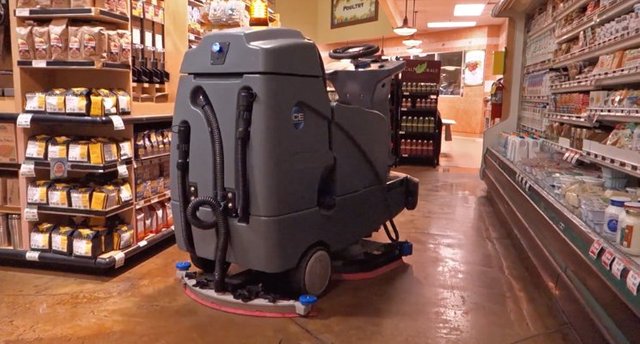Robots in action, For Walmart....
With its orange caution light, red bristles and bulky frame, the device looks like any other late-night floor cleaner, with one exception: No human is needed to operate it.

Walmart has quietly begun testing an advanced, autonomous floor scrubber during overnight shifts in five stores near the company's headquarters in Bentonville, Ark., a move that could free workers from hours of drudgery, but that has already raised alarm among some employees. As the U.S.’s largest private-sector employer, Walmart is watched carefully for any shifts it makes to its workplace.
The machine resembles a traditional scrubber but comes equipped with similar technology used in self-driving cars: extensive cameras, sensors, algorithms and Lidar for navigational mapping. Think of it as a Roomba crossed with a Tesla. A human must first drive the device to train it on a path; it can then operate largely independently, including when a store is open to customers. If a person or object gets in its way, it momentarily pauses and adjusts course.
The device is the creation of San Diego-based Brain Corp., according to a person familiar with the matter. The company, which will employ about 100 by year’s end, develops autonomous software and raised $114 million in Series C funding in July, led by Softbank’s $93 billion Vision Fund. A Brain Corp. representative said the company doesn’t comment about specific clients. A Walmart spokesperson, Kory Lundberg, confirmed the test but said it is still in a “proof of concept” phase. If successful, it could be rolled out to more stores.
“We’re always testing new ideas and new technology,” Lundberg said. “We still have a lot more to learn about how this technology will work best for our different retail locations.”
Multiple employees who work at the retailer's 24-hour Supercenter in Pineville, Mo., about 20 minutes north of Walmart's home office, confirmed the use of the device to me this week, saying it had been tested in their store for about a month this fall. In a private Facebook group earlier this month, someone who claims to be a worker at the Pineville store shared a photo of the greyish vehicle making a turn near a display for $78 deer feeders. No one is seated in the driver’s seat, and two “caution, cleaning in progress” banners are shown on both sides of the device. An ICE logo is also affixed; Holland, Mich.-based International Cleaning Equipment, a Brain Corp. partner, manufactures the scrubbing equipment itself.
Walmart has said it wants to automate tasks that are “repeatable, predictable and manual,” giving its people more time to focus on higher-value work like customer service and selling. It is putting shelf-scanning bots in 50 stores to more accurately check prices and inventory, it announced last month. The company said the bots would not lead to a drop in headcount.
Walmart’s test of the robotic floor cleaning device has not been previously reported.
In a Q&A with reporters in June, CEO Doug McMillon said that the retailer may need fewer people in the future as technology changes how its 1.5 million U.S. employees function. But he also added that the growth of the company’s online business had created thousands of new roles that did not previously exist in its stores and ecommerce fulfillment centers.
While many retailers have retrenched this year, Walmart has surged. Last week, shares hit an all-time high of $99.62 Thursday after the company reported some of its strongest sales in years. Online sales from sites like Walmart.com, Jet.com and Bonobos rose 50 percent. In a sign that it is increasingly open to testing new technology, Walmart also said Friday it had pre-ordered 15 of Tesla’s new electric tractor trailers, to be released in 2019.
Yet its vast footprint of physical stores remains its biggest differentiator in its competitive battle with Amazon. In stores, overnights have long been a time for employees to restock shelves and tidy up with few interruptions from customers. Cleaning aisle after aisle can take hours in particularly cavernous locations, and would seem to be a job that fits Walmart’s description of a repeatable, manual task ripe for automation.
The Brain Corp. device used at Walmart is named EMMA, a human, feminine moniker for what is ultimately an acronym: “Enabling Mobile Machine Automation.”
Phil Duffy, the vice president of innovation for Brain Corp., wouldn’t comment on whether the Walmart machine was made by his company, but explained that the 1-year-old EMMA is meant not as a replacement for humans but as a way to address challenges in the labor market.
Many companies struggle with high turnover and difficulties in hiring maintenance and janitorial staff to work third-shift positions. At retailers, typically only 20 percent of an overnight employee’s job is dedicated to floor cleaning, Duffy said, meaning the worker could also easily be repurposed elsewhere.
“[An employee] is spending three hours sitting on a machine, driving it around, when he could be used on much more higher-value tasks,” Duffy said.
Working with the robot also introduces hourly staffers to autonomous technology; they’re no longer riding a scrubber, they’re helping direct it, which could help employees gain new skills, Walmart's Lundberg said.
Brain Corp. makes the software that powers the robotic components for the machinery. It partners with existing cleaning equipment manufacturers to provide the scrubber itself.
While the company describes its product as part of a new wave of collaborative robotics — and refers to it as a “she” in marketing materials (“she keeps your neighborhood store clean”) — some Walmart employees see EMMA as more interloper than friend, at least for now.!
LINK